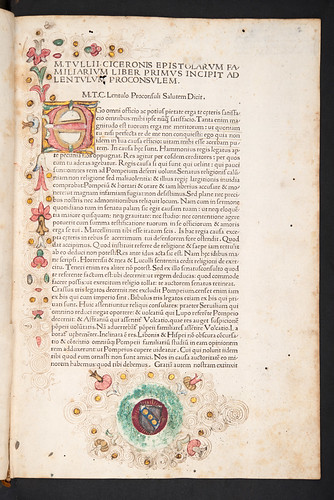Cicero, Marcus Tullius: Epistolae ad familiares.
[Venice: Vindelinus de Spira], 1471.
Fol. [112 2-910 1010 (10/2+χ1) 11-1210 138 146]. [137] leaves (1/1, 14/6 blank).
ISTC ic00509000; GW 6807; Goff C509; BMC V 158 (IB. 19530); CIBN C-346; BSB-Ink C-326.
| GIP number: | C53 |
| Shelf-mark: | Sp Coll Hunterian Be.1.6 (see main library entry for this item) |
| Variant: | 1/2r, lines 1-6 read “M. TVLLII CICERONIS EPISTOLARVM FA-||MILIARIVM LIBER PRIMVS INCIPIT AD || LENTVLVM PROCONSVLEM. || M.T.C. Lentulo Proconſuli Salutem Dicit. || [E]Go omni officio ac potiuſ pietate erga te cęteris ſatiſfa-||cio ...” as in Polain(B) 1069 and GW's main transcription, not as in BMC and GW Anm.; 2/1r (f. 13r), lines 1-2: “poſſum: ut abs te ... || cū eſſet ...” not as Polain “possum: ut abste ... || cū esses ...”; without the woodcut border at head of text on 1/2r as described in BMC. |
| Note: | Printer's pin-holes visible. |
| Note: | 10/χ1 misbound between 2/2 and 2/3 with its stub visible between 2/8 and 2/9. |
| Note: | Bifolium 14/3.4 (ff. 134 and 135) misbound between bifolia 10/2.9 and 10/3.8. |
| Provenance: | Unidentified owner: unidentified coat of arms on 1/2r: argent, on a bend azure three bezants. Unidentified Dutch owner (early 18th century): see Binding. Louis Jean Gaignat (1697-1768), Secretary to King Louis XV: Gaignat sale, 1769; lot 1476 in Guillaume de Bure, Bibliographie instructive: supplément ... ou catalogue des livres de feu M. L.J. Gaignat, 2 vols (Paris: 1769). NB according to the Bibliothèque Méjanes annotated copy (Res. O. 189) of the Gaignat sale catalogue, Gaignat bought the book for 104 livres. William Hunter (1718-1783), physician and anatomist: purchased by Hunter at the Gaignat sale through his agent, Jean-Baptiste Dessain, for 102 livres; see Dessain-Hunter correspondence (University of Glasgow Library, MS Gen. 36, f. 23v). University of Glasgow: Hunterian bequest, 1807; Hunterian Museum bookplate on front pastedown, with former shelfmark “T.5.13”. |
| Binding: | Netherlands, early 18th-century gold-tooled red goatskin; covers decorated with a roll (composed of a row of small diamond shapes bordered on each side by a row of dots) to form a two-panel design; the inner panel has a diamond-shaped centre-piece formed from separate tools (including drawer-handle and floral tools) and has an ornament at its four outer corners; gold-tooled spine; marbled endpapers; gilt-edged leaves; rear flyleaf has a bunch of grapes watermark. For this and a group of over 70 similar bindings, see Mirjam M. Foot, ‘An eighteenth-century incunable collector in The Hague’, in Incunabula: studies in fifteenth-century printed books presented to Lotte Hellinga, ed. by M. Davies (London: 1999) pp. 371-87, Appendix no. 10. Size: 349 x 236 mm. |
| Leaf size: | 338 x 232 mm. |
| Annotations: | Occasional marginal (washed-out) annotations in a humanist hand; underlining on 1/2r; number “10” in ink in an 18th-century hand on rear free endpaper. |
| Decoration: | Six-line initial “E” on 1/2r supplied in pink, crimson and green with white embellishment, and set on a square gold ground - from which floral decoration extends into the inner and upper margins; principal initials throughout supplied in a similar style and all combined with naturalistic sprigs of flowers in the outer margins (considerable bleeding of colours in many instances because of over-washing of the pages); smaller initials supplied in alternate red and blue throughout (the blue much washed-out); in the lower margin of 1/2r a coat of arms (argent, on a bend azure three bezants) within a green laurel leaf surrounded by floral decoration. |
| Imperfections: | None. |






